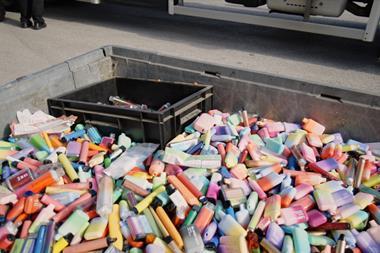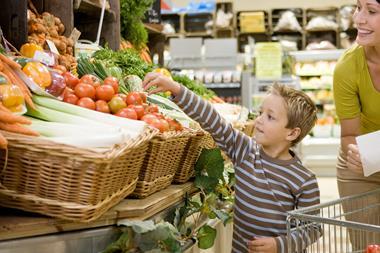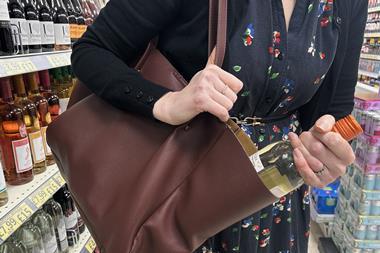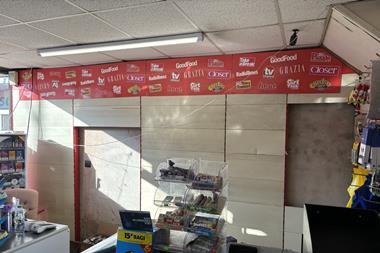The first step towards convincing someone to buy a product is obviously to ensure that they can actually see it. You know this only too well, which is why the countertop and gondola ends are such prized sales positions. But there is a golden spot that many retailers fail to capitalise on - the space just outside their store. It’s the area that customers see first, before they decide whether to enter the store, and can be used in a variety of ways.
“Everybody walks past the outdoor display to get into the store, so it’s a key sales position,” says West Sussex Budgens owner and Convenience Retailer of the Year David Knight. “We used to just use the shop exterior for A-frame advertising to try and push people into the store, but then we looked at other options. We saw an opportunity to work with local suppliers in horticulture, which is best sold outside, so we decided to take a gamble and see how it went.” David didn’t want to dive head first into the unknown, so initially he trialled bedding plants, which are in season for between eight and 10 weeks. “I’m not very green-fingered, so asked local suppliers to visit and see what they thought would work. We started with bedding plants on a multibuy deal - four plants for £10.”
Once he’d established that there was sufficient demand, David thought about what people needed all year round and changed the offering with the seasons. “We do ranges throughout the seasons, so in the summer the focus is on brightly coloured flowers, and at Christmas we’ll have gifting plants and evergreens. We also have roll cages to sell compost, gardening tools and hanging baskets.”
Sales are strong throughout the year, with horticulture making £3,000 in a recent week, while winter fuel helps to balance out the figures in the colder months. “We sell barbecue goods, and then coal and wood kindling in the winter, which is seeing 30% growth year on year,” says David.
The plants have provided more than extra revenue, though. David reports that they have also had a positive impact on the way customers perceive the entire store. “The feedback we’ve had from our customers has been fantastic. The whole frontage comes to life with colour in the spring. It gives an element of ‘fresh’ straight away.”
He urges other retailers to experiment with their store exteriors, adding that sticking with the usual line-up of trolleys won’t get you noticed. “Trolleys are important, but take up valuable sales space. When you consider that the average spend in many stores is a basket spend, you have to ask whether using the space for trollies is justified,” he says. “These days you have to be quirky to stand out.”
One pioneering retailer who isn’t afraid to be different is Andrew Thornton, owner of two Thornton’s Budgens stores in London. He has come up with a way to use his outdoor space by setting up a stall which is hired out to independent local businesses. “The Stall4All has helped to improve Thornton’s Budgens in offering another place for people in the community to sell their wares and show their creative or entrepreneurial skills,” says Thornton’s Budgens marketing manager Nathalie Quinn. While the main point of the stall is to encourage enterprise and build community links, it also helps the store to grow sales. “We can have traders who have products in store, too, so they can offer tastings and samplings, which helps sales.”
Stall4All co-ordinator Ana Remigio adds: “Stall4All has helped create a community atmosphere outside Budgens where people can stop and have a chat with our traders as they get to know to each other. Introducing an initiative like this would bring some individuality to a retailer’s business and support much smaller businesses.”
Chris Smith of Greensmiths in London’s Waterloo agrees that making the most of your outdoor space is all about causing a stir. He has a member of staff who takes responsibility for the store’s window displays, which incorporate local products as well as props such as wooden crates to communicate the store’s rustic qualities. “I’ve always been a great advocate of taking the inside out. It is a change from the norm, otherwise the store becomes wallpaper for those walking past because they get too used to it,” he says. Chris has tried all manner of unusual ideas to get people talking about his store. “We have a table of bread and pastries outside. Having them outdoors really helps to increase sales. We’ve set up a market stall there, too, and had someone carving meat for pork rolls. It really captures attention.”
Clearly, the cost of staffing an outdoor table has to be justified in terms of sales and footfall, but Chris believes it’s a worthwhile activity because of the theatre it creates. “The advantage is that you can interact with people,” he says.
In addition to engaging with customers, outdoor spaces can also be used to highlight the products and services that customers may not be aware you offer. “We have tables and chairs outside to let people know that we have a café,” says Chris. “You can only see about a fifth of the shop from the road due to its unusual shape, so the table and chairs flag up that there’s more than meets the eye.”
Singh’s Premier stores in Sheffield has adopted a similar tactic, using their outside space to draw customers’ attentions to products they may not expect to find on sale. “We put large sacks of potatoes and dog food on pallets backed up by bold signage outside our Teynham Road store,” says owner Mandeep Singh. “People don’t associate our size of store with big bags of pet food. It’s the kind of product they’d usually get from a specialist pet shop, so they wouldn’t think to come to us for it unless they spot it when passing. We’re selling a pallet-and-a-half a week as a result of displaying it outside.”
He has also used some key pieces of equipment to attract people’s attention. “We spent £3,500 on a totem pole outside our Herries Road store front. It displays internally lit advertising, including our logo, a bread and milk at 99p deal, the Euroshopper logo and additional services, such as PayPoint, Bake & Bite, National Lottery and our free cash machine,” says Mandeep. “It has a dusk til dark sensor so it turns on and off with light levels. There’s a high traffic flow past the store, so a lot of people see it.”
Mandeep also uses plenty of POS material outside to ensure people are aware of his good deals. “We have about eight poster frames on display outside the shop, alongside an LCD screen showing Sky Sports and Sky news, integrated with Premier adverts. It works a dream for attracting customers,” he says.
Zed Khan, who owns a Best One in Bury Old Road, Prestwich, Manchester, has made good use of POS outside his store. “We put up poster frames in the windows to tell people about our offers. I’ve had a customer tell me at the till: ‘I’d never have come in if I hadn’t seen your posters.’ She spent £30, so I know that it works.”
Zed’s trading situation is particularly tough as he is right next door to a Tesco Express, so it’s even more vital for him to make the most of his shop exterior. “Tesco spends a lot of money making sure that the store is up to scratch, so I have to ensure our exterior gets professionally cleaned every three weeks. I also keep my fruit and veg display outside to differentiate us from Tesco.
“I used to sell £100-worth of fresh a week, but now that it’s outside people can’t miss it and I do about £500. Every time we move it indoors, people can’t see it and it’s difficult to sell, even if it’s cheaper than Tesco. We don’t have the financial power that the multiples have to advertise, so we have to get the product out there to ensure it is seen.”
He claims that because the display looks so good that too helps to attract customers. “The colours - greens, oranges and reds - make a strong visual impact and we sell even more if it’s sunny because it really highlights the produce at its best.”
Whatever your circumstances, it is worth considering how your store appears from the outside and thinking about whether the space could be used more efficiently. Adds Zed: “First impressions are important. I know shop owners who have neglected the outside and you can’t help wondering how bad it is on the inside. It’s got to look attractive for people to come in.”■
legal requirements

Using outdoor space comes with its own rules, and it isn’t always easy to predict how local authorities will react to your plans. Thornton’s Budgens in London nearly lost its market stall as a result of traders being unaware that they were meant to pay licence fees. “We didn’t ask to use the space before we set up Stall4All because it is on Budgens’ private land and we didn’t think we had to,” says Stall4All co-ordinator Ana Remigio. “A council officer closed us down in June on the basis that we didn’t have a licence.” Thankfully, the stall was re-instated, although Thornton’s is now campaigning for a lower licence fee as the current £21 daily cost is deemed too expensive for traders.
The safest approach when planning an outdoor venture is not to make any assumptions. West Sussex store owner David Knight made sure he had written permission before setting up his outdoor horticulture fixture. “We didn’t want to fall out with the council about our space, so we invited the highways councillor to the store - we always take that approach with health and safety issues,” says David. “He appreciated the fact that we’d asked him for his opinion. He told us exactly what to do and we had a written plan to say how many square feet the area can be. He didn’t like our wobbling A-boards either in case they got blown in the wind and caused damage, so we took them down.”
If you are looking to set up street trading on your shop front, or even just set up a sign on the pavement, the first port of call should be your local district council. Provide as much detail as possible about where you are located, the days and times you wish to trade, and how much space your set-up will use. If at all possible, follow David’s lead and invite the authority to visit your store and see the space for themselves.



























No comments yet